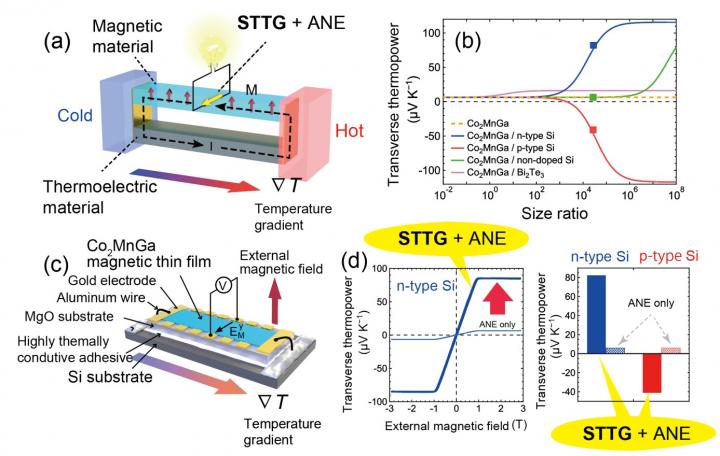Composite of thermoelectric and magnetic materials with high thermopower may open up a new way to wide-ranging energy applications

Credit: NIMS
A NIMS research team devised a new thermoelectric generation mechanism with a hybrid structure composed of thermoelectric and magnetic materials. The team then actually fabricated this structure and observed the record-high thermopower appearing in the direction perpendicular to a temperature gradient (i.e., transverse thermoelectric generation). These results may offer insights into new mechanisms and structural designs applicable to the development of versatile energy harvesting technologies and highly sensitive heat flux sensors.
The Seebeck effect is a phenomenon in which a temperature gradient across a metal or semiconductor is converted into a thermoelectric voltage. Because this effect can be used to convert waste heat into electrical energy, its potential applications (e.g., autonomous power sources for IoT devices) have been extensively studied. However, Seebeck-effect-driven thermoelectric generation has disadvantages: a thermopower is generated along the direction of a temperature gradient (i.e., longitudinal thermoelectric generation). Because of this parallel relationship, a thermoelectric material needs to be extended in the direction of a temperature gradient to create large temperature differences and resultant large thermoelectric voltage. Furthermore, in conventional Seebeck devices, a complex structure composed of a serial connection of many pairs of two different thermoelectric materials is necessary to enhance a thermoelectric voltage. However, these arrangements increase production cost, make the material/structure less durable, and limit its practical applicability. In contrast, the anomalous Nernst effect?a thermoelectric phenomenon that occurs only in magnetic materials?can generate a thermoelectric voltage perpendicular to the direction of a temperature gradient. This effect may thus enable generation of a thermopower in a transverse direction, and the thermoelectric voltage can be enhanced simply by increasing the length of the material in the direction perpendicular to a temperature gradient. Transversely extended thermoelectric materials are expected to have significantly greater flexibility when integrated into modules and to offset the aforementioned disadvantages related to the Seebeck effect. However, the anomalous Nernst effect has been shown to generate only a very small thermopower?less than 10 μV/K at near room temperature?making its practical application difficult.
In this research project, the research team devised and demonstrated a new thermoelectric generation mechanism in which a longitudinal thermopower induced by the Seebeck effect in a thermoelectric material can be converted into a transverse thermopower in a magnetic material via the anomalous Hall effect. The team then simulated this mechanism based on phenomenological model calculations and found it potentially capable of generating very high thermopower beyond 100 μV/K perpendicular to the direction of a temperature gradient when materials and structures are optimized. To experimentally verify this result, the team fabricated a hybrid structure composed of Co2MnGa?a magnetic compound capable of producing the large anomalous Hall effect?and semiconducting Si capable of producing the large Seebeck effect. This structure generated the record-high positive and negative transverse thermopowers (+82 μV/K and -41 μV/K). The magnitude and sign of the measured thermopowers are well reproduced by the prediction based on the model calculations. The thermoelectric generation capability of the composite can further be improved by material and structural optimization.
The thermopower observed in this project was more than 10 times larger than the previously recorded highest thermopower generated by the anomalous Nernst effect. This result is expected to significantly advance R&D efforts aiming to put transverse thermoelectric generation into practical use. In future studies, we plan to research and develop effective magnetic and thermoelectric materials, create composite structures using these materials, and optimize their structures. We will then use these hybrid materials to develop energy harvesting technologies capable of powering IoT devices and heat flux sensors that can be used for energy-saving purposes.
###
This project was carried out by the research team led by Weinan Zhou (Postdoctoral Researcher, Magnetic Materials Group, NIMS), Yuya Sakuraba (Group Leader of Magnetic Materials Group, NIMS), Ken-ichi Uchida (Group Leader of Spin Caloritronics Group, NIMS), and Kaoru Yamamoto (Postdoctoral Researcher, Spin Theory Group, NIMS; relocated after this research). This work was conducted in conjunction with the following research projects entitled “Development of novel spiral type thermoelectric power generation using anomalous Nernst effect” (research director: Yuya Sakuraba, project number: JPMJPR17R5) supported by the JST Strategic Basic Research Program PRESTO and “Spintronic thermal management” (research director: Ken-ichi Uchida, project number: JPMJCR17I1) supported by the JST Strategic Basic Research Program CREST. This work was also supported by the NEDO Feasibility Study Program under the Uncharted Territory Challenge 2050 category (project code: P14004). This research was published in the online version of Nature Materials, a British scientific journal, at 1:00 am on January 19, 2021, Japan Time (4:00 pm on January 18, GMT).
Contacts
(Regarding this research)
Yuya Sakuraba
Group Leader
Magnetic Materials Group
Research Center for Magnetic and Spintronic Materials
National Institute for Materials Science
Tel: +81-29-859-2708
Email: SAKURABA.Yuya=nims.go.jp
(Please change “=” to “@”)
URL: https:/
Ken-ichi Uchida
Group Leader
Spin Caloritronics Group
Research Center for Magnetic and Spintronic Materials
National Institute for Materials Science
Tel: +81-29-859-2062
Email: UCHIDA.Kenichi=nims.go.jp
(Please change “=” to “@”) URL: https:/
(General information)
Public Relations Office
National Institute for Materials Science
Tel: +81-29-859-2026, Fax: +81-29-859-2017
Email: pressrelease=ml.nims.go.jp
(Please change “=” to “@”)
Public Relations Division
Japan Science and Technology Agency
5-3 Yonbancho, Chiyoda-ku, Tokyo 102-8666, Japan
Tel: +81-3-5214-8404, Fax: +81-3-5214-8432
Email: jstkoho=jst.go.jp
(Please change “=” to “@”)
(Regarding JST programs)
Yuko Shimabayashi
Green Innovation Group, Department of Innovation Research
Japan Science and Technology Agency
K’s Gobancho, 7 Gobancho, Chiyoda-ku, Tokyo 102-0076, Japan
Tel: +81-3-3512-3525, Fax: +81-3-3222-2067
Email: presto=jst.go.jp
(Please change “=” to “@”)
Media Contact
Yasufumi Nakamichi
[email protected]
Original Source
https:/
Related Journal Article
http://dx.




